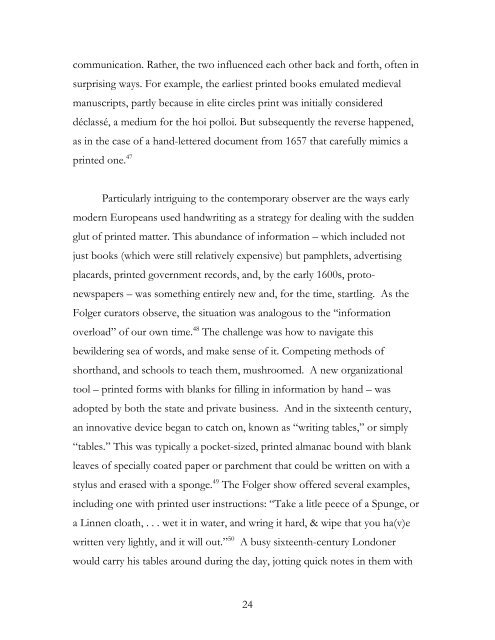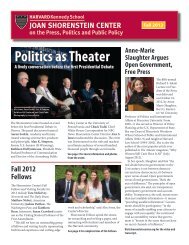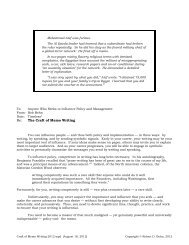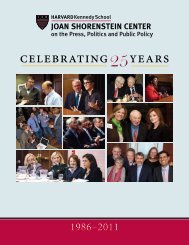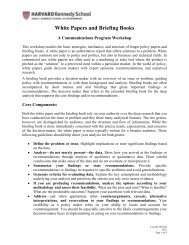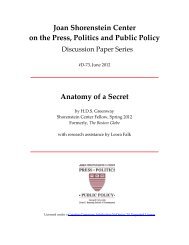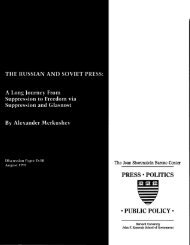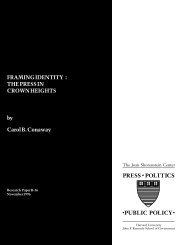Why Paper Is Eternal - Joan Shorenstein Center on the Press ...
Why Paper Is Eternal - Joan Shorenstein Center on the Press ...
Why Paper Is Eternal - Joan Shorenstein Center on the Press ...
Create successful ePaper yourself
Turn your PDF publications into a flip-book with our unique Google optimized e-Paper software.
communicati<strong>on</strong>. Ra<strong>the</strong>r, <strong>the</strong> two influenced each o<strong>the</strong>r back and forth, often in<br />
surprising ways. For example, <strong>the</strong> earliest printed books emulated medieval<br />
manuscripts, partly because in elite circles print was initially c<strong>on</strong>sidered<br />
déclassé, a medium for <strong>the</strong> hoi polloi. But subsequently <strong>the</strong> reverse happened,<br />
as in <strong>the</strong> case of a hand-lettered document from 1657 that carefully mimics a<br />
printed <strong>on</strong>e. 47<br />
Particularly intriguing to <strong>the</strong> c<strong>on</strong>temporary observer are <strong>the</strong> ways early<br />
modern Europeans used handwriting as a strategy for dealing with <strong>the</strong> sudden<br />
glut of printed matter. This abundance of informati<strong>on</strong> – which included not<br />
just books (which were still relatively expensive) but pamphlets, advertising<br />
placards, printed government records, and, by <strong>the</strong> early 1600s, proto-<br />
newspapers – was something entirely new and, for <strong>the</strong> time, startling. As <strong>the</strong><br />
Folger curators observe, <strong>the</strong> situati<strong>on</strong> was analogous to <strong>the</strong> “informati<strong>on</strong><br />
overload” of our own time. 48 The challenge was how to navigate this<br />
bewildering sea of words, and make sense of it. Competing methods of<br />
shorthand, and schools to teach <strong>the</strong>m, mushroomed. A new organizati<strong>on</strong>al<br />
tool – printed forms with blanks for filling in informati<strong>on</strong> by hand – was<br />
adopted by both <strong>the</strong> state and private business. And in <strong>the</strong> sixteenth century,<br />
an innovative device began to catch <strong>on</strong>, known as “writing tables,” or simply<br />
“tables.” This was typically a pocket-sized, printed almanac bound with blank<br />
leaves of specially coated paper or parchment that could be written <strong>on</strong> with a<br />
stylus and erased with a sp<strong>on</strong>ge. 49 The Folger show offered several examples,<br />
including <strong>on</strong>e with printed user instructi<strong>on</strong>s: “Take a litle peece of a Spunge, or<br />
a Linnen cloath, . . . wet it in water, and wring it hard, & wipe that you ha(v)e<br />
written very lightly, and it will out.” 50 A busy sixteenth-century L<strong>on</strong>d<strong>on</strong>er<br />
would carry his tables around during <strong>the</strong> day, jotting quick notes in <strong>the</strong>m with<br />
24


